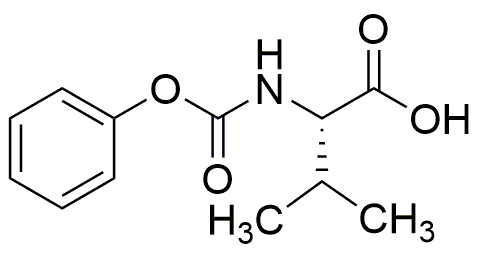N-(Phenoxycarbonyl)-L-valine is widely utilized in research focused on:
- Peptide Synthesis: This compound serves as a key building block in the synthesis of peptides, which are essential in drug development and biochemistry. Its unique structure allows for the incorporation of specific functionalities that enhance peptide stability and activity.
- Drug Development: In pharmaceutical research, it is used to create prodrugs that improve the bioavailability of active pharmaceutical ingredients. This can lead to more effective medications with fewer side effects.
- Biotechnology: The compound is employed in the production of modified amino acids, which are crucial for developing novel biotherapeutics and diagnostics. Its application can lead to more targeted therapies in diseases like cancer.
- Research in Enzyme Inhibition: It is utilized in studies aimed at understanding enzyme mechanisms, particularly in the design of inhibitors that can regulate biological pathways, offering potential treatments for various conditions.
- Cosmetic Formulations: The compound is also explored in the cosmetic industry for its potential in formulating anti-aging products, leveraging its properties to enhance skin absorption and efficacy.
General Information
Properties
Safety and Regulations
Applications
N-(Phenoxycarbonyl)-L-valine is widely utilized in research focused on:
- Peptide Synthesis: This compound serves as a key building block in the synthesis of peptides, which are essential in drug development and biochemistry. Its unique structure allows for the incorporation of specific functionalities that enhance peptide stability and activity.
- Drug Development: In pharmaceutical research, it is used to create prodrugs that improve the bioavailability of active pharmaceutical ingredients. This can lead to more effective medications with fewer side effects.
- Biotechnology: The compound is employed in the production of modified amino acids, which are crucial for developing novel biotherapeutics and diagnostics. Its application can lead to more targeted therapies in diseases like cancer.
- Research in Enzyme Inhibition: It is utilized in studies aimed at understanding enzyme mechanisms, particularly in the design of inhibitors that can regulate biological pathways, offering potential treatments for various conditions.
- Cosmetic Formulations: The compound is also explored in the cosmetic industry for its potential in formulating anti-aging products, leveraging its properties to enhance skin absorption and efficacy.
Documents
Safety Data Sheets (SDS)
The SDS provides comprehensive safety information on handling, storage, and disposal of the product.
Product Specification (PS)
The PS provides a comprehensive breakdown of the product’s properties, including chemical composition, physical state, purity, and storage requirements. It also details acceptable quality ranges and the product's intended applications.
Certificates of Analysis (COA)
Search for Certificates of Analysis (COA) by entering the products Lot Number. Lot and Batch Numbers can be found on a product’s label following the words ‘Lot’ or ‘Batch’.
*Catalog Number
*Lot Number
Certificates Of Origin (COO)
This COO confirms the country where the product was manufactured, and also details the materials and components used in it and whether it is derived from natural, synthetic, or other specific sources. This certificate may be required for customs, trade, and regulatory compliance.
*Catalog Number
*Lot Number
Safety Data Sheets (SDS)
The SDS provides comprehensive safety information on handling, storage, and disposal of the product.
DownloadProduct Specification (PS)
The PS provides a comprehensive breakdown of the product’s properties, including chemical composition, physical state, purity, and storage requirements. It also details acceptable quality ranges and the product's intended applications.
DownloadCertificates of Analysis (COA)
Search for Certificates of Analysis (COA) by entering the products Lot Number. Lot and Batch Numbers can be found on a product’s label following the words ‘Lot’ or ‘Batch’.
*Catalog Number
*Lot Number
Certificates Of Origin (COO)
This COO confirms the country where the product was manufactured, and also details the materials and components used in it and whether it is derived from natural, synthetic, or other specific sources. This certificate may be required for customs, trade, and regulatory compliance.


